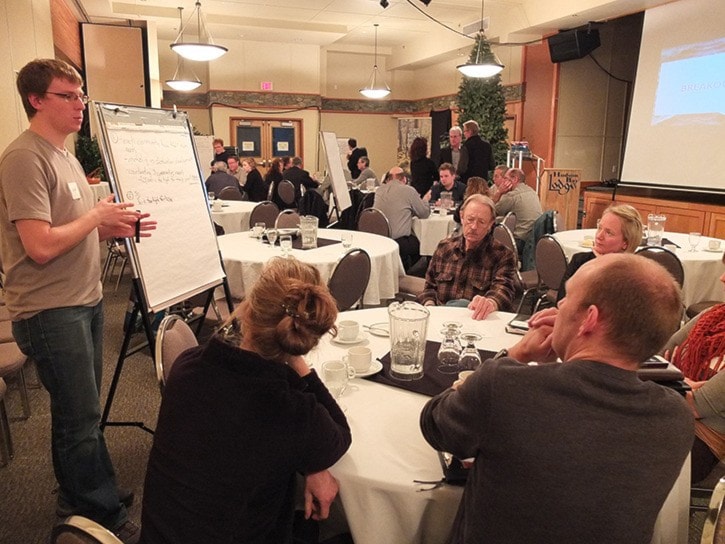Tourism stakeholders aired their concerns about proposed changes to Destination BC’s funding structure at an information session with the provincial tourism organization in Smithers last week.
DBC announced in October it was planning a restructure to reduce duplication and align the work of regional tourism associations, such as Northern BC Tourism, with the provincial marketing strategy.
After the announcement, Smithers tourism stakeholders voiced concerns the changes could downsize existing tourism groups and reduce access to funding for locally-supported projects.
To provide more information about the changes, and its new marketing brand, DBC is holding information sessions at 15 different communities throughout the province.
DBC partnership marketing director Peter Harrison, global marketing vice president Maya Lange and destination and industry development vice-president Grant Mackay travelled to Smithers for last Monday’s presentation at the Hudson Bay Lodge.
Mackay and Lange started the presentation by providing a summary of DBC’s marketing approach, both internationally and within Canada, with a campaign that aims to conjure emotion surrounding nature and wilderness in B.C.
Harrison then presented the details of how the proposed new funding model would work.
An application-based program, it would consist of two funding pools, one reserve and one open.
Groups could apply to the reserve funding pool for projects that align with DBC’s three priority areas of skiing, Aboriginal tourism, and touring and exploring.
Through the open pool, groups could apply for between $25,000 and $250,000 for collaborative projects developed by communities, tourism associations or business sectors, such as golfing or wine.
In a question and answer session after the presentations, Tourism Smithers marketing director Gladys Atrill said DBC should reconsider the open pool system because it could put smaller regions at a disadvantage.
“When I hear that there is going to be the same amount of money in the region but a part of it is in an open pool that is going to be application-based, by communities and by sectors, I start to get a little bit queasy,” she said.
“If there’s going to be dedicated funding for the region put that number down.
“Maybe we need to look at the open pool because I’m not sure we have the capacity in the region to apply for that in the same way that people do in other parts of the region.”
She said she was supportive of a more streamlined provincial approach, but the “devil was in the details.”
“The notion that we do things better, the notion that we cooperate, I think we do and I think we’d all like to, but we need to have some ability to do that in a way that functions for the region and we need to be able to work with the regional office (Northern BC Tourism).”
Addressing Harrison, Mayor Taylor Bachrach said the fate of Northern BC Tourism was “the elephant in the room.”
“If you acknowledge that northern B.C. is an exceptional region, how will that difference as a region be reflected in the plan that takes place a year from now?” he said.
“Because there are some real concerns in our communities.”
Mackay responded by saying DBC recognized trends and patterns in northern B.C. were different to those in the Lower Mainland.
“As things have changed throughout the other 50 per cent of the province it has not changed as dramatically in the north and there needs to be an organization,” he said.
“As the regions were created a long time ago, they were the glue that tried to keep all of the communities together. That glue still needs to be here in northern B.C. and we understand that.
“We also understand that the world is changing and we want to talk about new roles.”
The session ended with a workshop where people were asked to form a group and collaboratively answer a set series of questions about the new brand and the changes.
Attendees also received an individual feedback form.
Harrison said DBC had heard a variety of comments at the sessions to date.
“I think that it’s been positive comments,” he said.
“People are really happy that we’ve come out to listen to their opinion and we are hearing lots of different perspectives.”
Consultations will continue with a tourism marketing sub-committee in January and February.
Another marketing committee and a market research firm will then consider the feedback.
Harrison said the transition to the new program would take place over the next 17 months, with a view to implementing it fully by April 2016.
